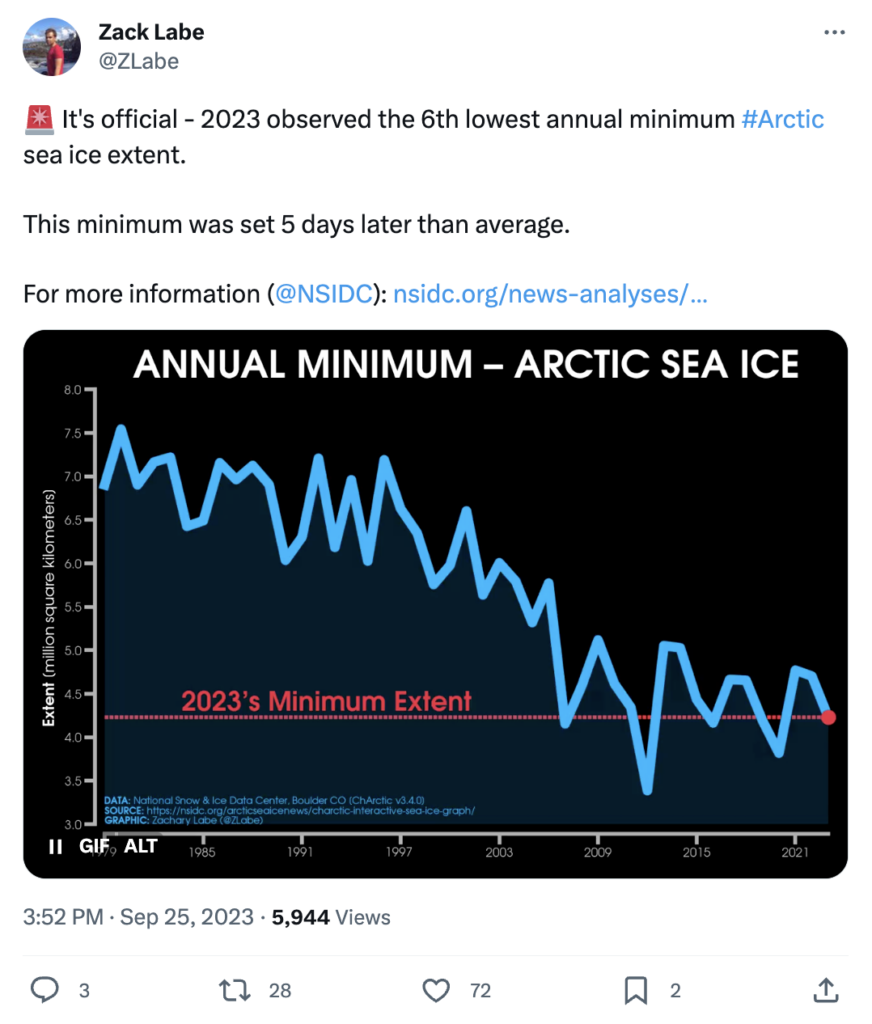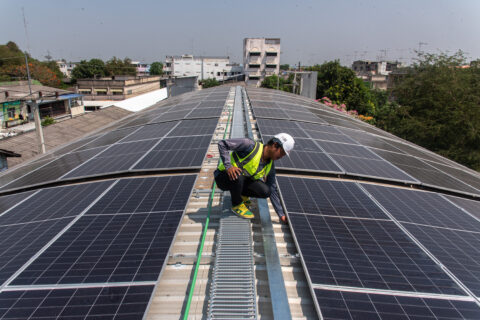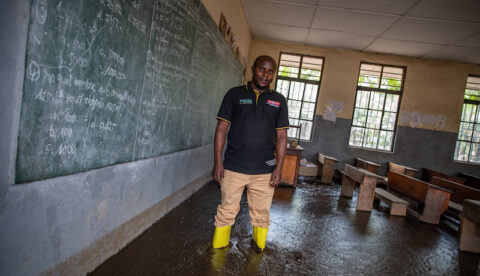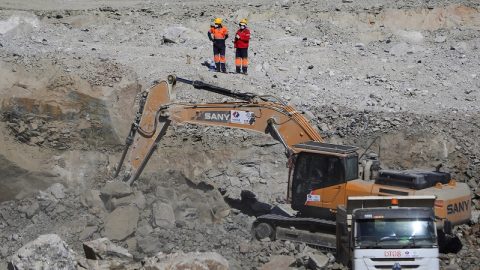Global sea ice extent is at a record low for this time of year, due to rapid Antarctic sea ice melt and below-average Arctic coverage, new data reveals.
Antarctic sea ice extent has been tracking at record-low levels for almost the entire year, making headlines around the world.
It has now reached its annual maximum for the year, clocking in at 16.96m km2 on 10 September, according to provisional data from the National Snow and Ice Data Centre (NSIDC).
This is the smallest Antarctic sea ice maximum in the 45-year satellite record by “a wide margin”, the NSIDC says, and one of the earliest.
Antarctic conditions this year have been “truly exceptional” and “completely outside the bounds of normality”, one expert tells Carbon Brief.
Meanwhile, Arctic sea ice extent reached its minimum for the year at 4.23m square kilometres (km2) on 19 September.
This is the sixth-lowest minimum on record and 1.99m km2 below the average maximum recorded over 1981-2010.
Record low global sea ice
Arctic sea ice has been melting for months, driven by long sunny days and warm temperatures. But, as winter approaches, the melt season has now come to an end. Arctic sea ice reached its minimum for the year on 19 September and is now growing towards its winter peak.
At the Earth’s other pole, the opposite is happening. Antarctic sea ice – which has been growing since February – reached its winter peak on 10 September. Its melt season has now begun.
Using satellite data, scientists track the seasonal growth and melt of sea ice, allowing them to determine the size of the annual minima and maxima. Recording the sea ice extent at each pole – the area of ocean with at least 15% sea ice coverage – is a key way to monitor the “health” of Antarctic sea ice.
The plots below show Arctic (left) and Antarctic (right) sea ice extent over June-October. Sea ice extent in 2023 is shown in blue, the 1981-2010 average in grey and other years in other colours.

In the Antarctic, sea ice extent has been tracking at record-low levels for months. Dr Ella Gilbert – a regional climate modeller at the British Antarctic Survey – tells Carbon Brief that Antarctic conditions this year have been “truly exceptional” and “completely outside the bounds of normality”.
Global sea ice extent – the sum of sea ice extent in the Arctic and Antarctic – has also been tracking at a record low for months.
The plot below shows the combined sea ice extent for the Arctic and Antarctic. The red line indicates sea ice extent in 2023, yellow shows 2016 and other blue lines indicate other years dating back until 1979 when the satellite record began.

‘Exceptional’ Antarctic melt
The Antarctic has attracted widespread media attention throughout this year. In February, Antarctic sea ice extent reached its summer minimum extent of 1.79m km2, setting the record for a second straight year.
Commenting on the new record low minimum – the third record to be set in seven years – one study warned that the Antarctic had entered a “new state”, in which the underlying processes controlling Antarctic sea ice coverage “may have altered”.
As the weather cooled in March, Antarctic sea ice “expanded at a fairly typical pace”, according to the NSIDC. Nonetheless, March 2023 average sea ice extent was the second lowest on record.
Antarctic sea ice extent remained “sharply below average throughout” April, clocking in with the second lowest daily extent on record by the end of the month.
Gilbert tells Carbon Brief that Antarctic sea ice “never really recovered” from its record-low February minimum, thanks to a “slow freeze-up”.
Antarctic sea ice grew only 2.87m km2 over May 2023 – considerably less than the average growth of 3.25m km2. Air temperatures were up to 4C above average over the Weddell sea during the month, but around 4C below average over the Amusden sea.
By 31 May, Antarctic sea ice extent was again at a record low extent, clocking in at around 700,000 km2 smaller than the previous daily record lows recorded in 1980, 2017 and 2019. Sea ice continued to track at “extreme record low levels” throughout June, according to the NSIDC.
The graphic below shows Antarctic daily sea ice extent in 2023 (red) compared to previous years over 1979-2023.

Dr Zachary Labe is a postdoctoral researcher working at NOAA Geophysical Fluid Dynamics Laboratory and the Atmospheric and Oceanic Sciences Program at Princeton University, and a Carbon Brief contributing editor.
He tells Carbon Brief that the record lows are linked to “both oceanic and atmospheric factors”, especially related to the strength of the Amundsen Sea Low – a low pressure trough named after the sea off West Antarctica that it typically sits above.
“Exceptionally low” sea ice extent continued into July, with the NSIDC noting that Antarctic ice extent as of mid-July was “more than 2.6 km2 below the 1981-2010 average, an area nearly as large as Argentina”. Antarctic sea ice extent was particularly low in the northern Weddell Sea, western Ross Sea and southern Bellingshausen Sea.
Antarctic sea ice continued to grow slowly as the season progressed. Average extent was at a record low in July, clocking in at 1.50m km2 below the previous record low set in 2022, the NSIDC noted. It added at the time:
“There is speculation that the Antarctic sea ice system has entered a new regime, in which ocean heat is now playing a stronger role in limiting autumn and winter ice growth and enhancing spring and summer melt.”
The graphic below shows Antarctic sea ice thickness in July 2023 (left) and the difference in sea ice thickness between July 2023 the 1981-2010 July average (right). In the right-hand map, the areas of deepest red show where sea ice thickness in July this year was below average.

By the beginning of August, Antarctic sea ice growth began to level off. On 15 August, Antarctic sea ice extent was 1.73m km2 below the previous record low for the date, which was set in 1986.
Antarctic sea ice growth then picked up as the month progressed. It continued to track at a record low, but increased more than average in the Bellingshausen and Amundsen Seas as well as in the Pacific Ocean.
On 10 September, Antarctic sea ice likely reached its annual maximum extent of 16.96m km2. This is the lowest sea ice maximum in the 45-year by “a wide margin”, the NSIDC says. The previous record-low Antarctic minimum extent was 17.99m km2.
It adds that this year’s winter peak is one of the earliest on record – 13 days earlier than the 1981-2010 average date of 23 September.
The plot below shows Antarctic sea ice extent on 10 September, with the median sea ice extent for 1981-2010 shown by the orange line.

Gilbert notes that scientists have “no evidence of comparably low winter extent in the satellite record, nor in reconstructions of the last century or so”, adding:
“Given how variable sea ice is, it’s hard to say for certain whether this is the beginning of a longer-term shift towards a new regime in Antarctic sea ice. However, climate models predict that Antarctic sea ice will decline, and I think it’s only a matter of time until we see the signature of climate warming in Antarctic sea ice trends.”
The record low Antarctic sea ice levels have received widespread attention in the media in recent months, with BBC News, the Times and the Daily Telegraph calling the record-low sea ice levels “mind–blowing” and “dramatic”.
The impact on wildlife has also caused alarm. At the end of August, multiple outlets reported on a new study that found thousands of emperor penguin chicks in Antarctica had died because of record-low sea ice levels in 2022.
And new research warns that the Antarctic is also warming twice as fast as the global average. (It is already well established that the Arctic has warmed four times faster than the global average over the past four decades.)
Arctic minimum
At the Earth’s other pole, the season has been less eventful.
The Arctic reached its winter peak on 6 March 2023 with a sea ice extent of 14.62m km2 – the fifth smallest winter peak in the 45-year satellite record. This point marked the beginning of the melt season for the year.
Arctic sea ice extent declined in the week following the March peak, but cool weather nearly halted the ice melt during the second half of the month. Slow Arctic ice melt continued throughout April with “only” 20,600 km2 of ice lost per day on average, according to the NSIDC.
Slower-than-average sea ice melt persisted throughout much of May. Air temperatures over the Arctic ocean were around 1-4C below average throughout the month – except for over the Barents, Kara, and Beaufort Seas, where temperatures were 2-6C above average.
The map below shows the regional seas that make up the Arctic Ocean.

Sea ice melt sped up as the season progressed, resulting in faster-than-average melting throughout June. By the end of that month, average Arctic sea ice extent was 10.96m km2 – the 13th lowest for the time of year in the satellite record.
Arctic sea ice extent declined at a near-average pace throughout July, clocking in at the 12th lowest in the satellite record for the time of year.
However, record-breaking heat swept across the world in August, causing Arctic sea ice melt to accelerate, the NSIDC noted at the time.
Temperatures in the first half of August were “below average north of Greenland, above average in the Chukchi and East Siberian Seas, and considerably above average in the Kara and Barents Seas,” the NSIDC said.
The maps below shows absolute air temperatures in the Arctic in August 2023 (left) and the difference in air temperature between August 2023 the 1981-2010 August average (right). In the right-hand map, the areas of deepest red show where August this year was substantially hotter than average.

By the middle of August, sea ice extent was near average on the Atlantic side of the Arctic, but “well below average” in most other regions other than a tongue of ice extending toward the coast in the East Siberian Sea, the NSIDC said:
“The Northwest Passage appears to be on the verge of becoming nearly ice free, particularly the southern route, known as Amundsen’s route.”
As is typical of August, the pace of sea ice loss slowed during the second half of the month as cooler conditions set in.
The left-hand map below shows Arctic sea ice concentration – a measure of the amount of sea ice in a given area, usually described as a percentage – during August 2023. The areas shaded white indicate a high concentration.
The right-hand map shows the difference between this August and the 1981-2010 average, where red indicates a lower sea ice concentration in 2023 than the baseline.

Labe tells Carbon Brief that there have been some “particularly large regional extremes” around the Arctic this season.
For example, he highlights the “massive amount of open water on the Pacific side of the Arctic, which stretches from the Beaufort Sea to the East Siberian Sea”. Sea ice extent in this region dropped to the second lowest in the satellite-era, beaten only in the year 2012, he says.
Labe adds that within the main Arctic ice pack, there are “many areas of open water” this year, indicating that the ice is not very compacted. By mid September, sea-ice area – a measure of how compacted the ice is – reached its fourth lowest for the time of year, he says.
He also notes that sea ice was “significantly thinner than average in the Beaufort sea region” in August.
Arctic sea ice extent reached its minimum for the year at 4.23m square kilometres (km2), on 19 September, according to the NSIDC. This is the sixth lowest in a satellite record – 1.99m km2 smaller than the average minimum over 1981-2010 .
Days before the minimum was announced, the Marine Climate Change Impacts Partnership published a review paper on Arctic sea ice. It found that the September minimum Arctic sea ice extent has reduced by around 12% per decade compared to the 1981-2010 average.
It added:
“More than half the observed loss of Arctic sea ice can be directly attributed to warming caused by anthropogenic greenhouse gas emissions.”
Labe tells Carbon Brief that the Arctic today is “radically different” than it was only two or three decades ago. “This is due to human-caused climate change,” he says.

According to the NSIDC, the 17 lowest Arctic sea ice minima on record have occurred in the past 17 years.
The post ‘Exceptional’ Antarctic melt drives months of record-low global sea ice cover appeared first on Carbon Brief.
‘Exceptional’ Antarctic melt drives months of record-low global sea ice cover
Climate Change
Colombia proposes expert group to advance talks on minerals agreement
Colombia wants countries to discuss options for a global agreement to ensure that the extraction, processing and recycling of minerals – including those needed for the clean energy transition – don’t harm the environment and human wellbeing.
The mineral-rich nation is proposing to create an expert group to “identify options for international instruments, including global and legally-binding instruments, for coordinated global action on the environmentally sound management of minerals and metals through [their] full lifecyle”.
Colombia hopes this will eventually lead to an agreement on the need for an international treaty to define mandatory rules and standards that would make mineral value chains more transparent and accountable.
The proposal was set out in a draft resolution submitted to the UN Environment Assembly (UNEA) earlier this week and seen by Climate Home News. UNEA, which is constituted of all UN member states, is the world’s top decision-making body for matters relating to the environment. The assembly’s seventh session will meet in Kenya in December to vote on countries’ proposals.
Soaring demand for the minerals used to manufacture clean energy technologies and electric vehicles, as well as in the digital, construction and defence industries have led to growing environmental destruction, human rights violations and social conflict.
Colombia argues there is an “urgent need” to strengthen global cooperation and governance to reduce the risks to people and the planet.
Options for a global minerals agreement
The proposal is among a flurry of initiatives to strength global mineral governance at a time when booming demand is putting pressure on new mining projects.
Colombia, which produces emeralds, gold, platinum and silver for exports, first proposed the idea for a binding international agreement on minerals traceability and accountability on the sidelines of the UN biodiversity talks it hosted in October 2024.
Since then, the South American nation has been quietly trying to drum up support for the idea, especially among African and European nations.
Its draft resolution to UNEA7 contains very few details, leaving it open for countries to discuss what kind of global instrument would be best suited to make mineral supply chains more transparent and sustainable.
Does the world need a global treaty on energy transition minerals?
Colombia says it wants the expert group to build on other UN initiatives, including a UN Panel on Critical Energy Transition Minerals, which set out seven principles to ensure the mining, processing and recycling of energy transition minerals are done responsibly and benefit everyone.
The group would include technical experts and representatives from international and regional conventions, major country groupings as well as relevant stakeholders.
It would examine the feasibility and effectiveness of different options for a global agreement, consider their costs and identify measures to support countries to implement what is agreed.
The resolution also calls for one or two meetings for member states to discuss the idea before the UNEA8 session planned in late 2027, when countries would decide on a way forward.
No time to lose for treaty negotiations
Colombia’s efforts to advance global talks on mineral supply chains have been welcomed by resource experts and campaigners. But not everyone agrees on the best strategy to move the discussion forward at a time when multilateralism is coming under attack.
Johanna Sydow, a resource policy expert who heads the international environmental policy division of the Heinrich-Böll Foundation, said she had hoped that the resolution would explicitly call for negotiations to begin on an international minerals treaty.
“Treaty negotiations take a long time. If you don’t even start with it now, it will take even longer. I don’t see how in two or three years it will be easier to come to an agreement,” she told Climate Home.
Despite the geopolitical challenges, “we need joint rules to prevent a huge race to the bottom for [mineral] standards”. That could start with a group of countries coming together and starting to enforce joint standards for mining, processing and recycling minerals, she said.
But any meaningful global agreement on mineral supply chains would require backing from China, the world’s largest processor of minerals, which dominates most of the supply chains. And with Colombia heading for an election in May, it will need all the support it can get to move its proposal forward.
‘Voluntary initiative won’t cut it’
Juliana Peña Niño, Colombia country manager at the Natural Resource Governance Institute, is more optimistic. “Colombia’s leadership towards fairer mineral value chains is a welcome step,” she told Climate Home News.
“At UNEA7, we need an ambitious debate that gives the proposed expert group a clear mandate to advance concrete next steps — not delay decisions — and that puts the voices of those most affected at the centre. One thing is clear: the path forward must ultimately deliver a binding instrument, as yet another voluntary initiative simply won’t cut it,” she said.
More than 50 civil society groups spanning Latin America, Africa and Europe previously described Colombia’s work on the issue as “a chance to build a new global paradigm rooted in environmental integrity, human rights, Indigenous Peoples’ rights, justice and equity”.
“As the energy transition and digitalisation drive demand for minerals, we cannot afford to repeat old extractive models built on asymmetry – we must redefine them,” they wrote in a statement.
Main image: The UN Environment Assembly is hosted in Nairobi, Kenya. (Natalia Mroz/ UN Environment)
The post Colombia proposes expert group to advance talks on minerals agreement appeared first on Climate Home News.
Colombia proposes expert group to advance talks on minerals agreement
Climate Change
California Sanctions Stark Disparities in Pesticide Exposure During Pregnancy
If you’re young, pregnant and Latina, chances are you live near agricultural fields sprayed with higher levels of brain-damaging organophosphate pesticides.
A baby in the womb has few defenses against industrial petrochemicals designed to kill.
California Sanctions Stark Disparities in Pesticide Exposure During Pregnancy
Climate Change
DeBriefed 3 October 2025: UK political gap on climate widens; Fossil-fuelled Typhoon Ragasa; ‘Overshoot’ unknowns
Welcome to Carbon Brief’s DeBriefed.
An essential guide to the week’s key developments relating to climate change.
This week
Shattered climate consensus
FRACKING BAN: UK energy secretary Ed Miliband has announced that the government will bring forward its plans to permanently ban fracking, in a move designed to counter a promise from the hard-right Reform party to restart efforts to introduce the practice, the Guardian said. In the same speech, Miliband said Reform’s plans to scrap clean-energy projects would “betray” young people and future generations, the Press Association reported.
ACT AXE?: Meanwhile, Kemi Badenoch, leader of the Conservatives, pledged to scrap the 2008 Climate Change Act if elected, Bloomberg reported. It noted that the legislation was passed with cross-party support and strengthened by the Conservatives.
‘INSANE’: Badenoch faced a backlash from senior Tory figures, including ex-prime minister Theresa May, who called her pledge a “catastrophic mistake”, said the Financial Times. The newspaper added that the Conservatives were “trailing third in opinion polls”. A wide range of climate scientists also condemned the idea, describing it as “insane”, an “insult” and a “serious regression”.
Around the world
- CLIMATE CRACKDOWN: The US Department of Energy has told employees in the Office of Energy Efficiency and Renewable Energy to avoid using the term “climate change”, according to the Guardian.
- FOREST DELAY: Plans for Brazil’s COP30 flagship initiative, the tropical forests forever fund, are “suffer[ing] delays” as officials remain split on key details, Bloomberg said.
- COP MAY BE ‘SPLIT’: Australia could “split” the hosting of the COP31 climate summit in 2026 under a potential compromise with Turkey, reported the Guardian.
- DIVINE INTERVENTION: Pope Leo XIV has criticised those who minimise the “increasingly evident” impact of global warming in his first major climate speech, BBC News reported.
€44.5 billion
The cost of extreme weather and climate change in the EU in the last four years – two-and-a-half times higher than in the decade to 2019, according to a European Environment Agency report covered by the Financial Times.
Latest climate research
- Fossil-fuelled climate change caused around 36% of Typhoon Ragasa’s direct damage to homes and properties in southern China, according to a rapid impact attribution study | Imperial Grantham Institute – Climate Change and the Environment
- Some 86% of the global population are concerned about climate change, according to a survey of 280,000 people in 142 countries and regions | Climate Policy
- A global shift towards a “planetary health diet” could slash emissions and save tens of thousands of lives each day | EAT-Lancet Commission 2025 report
(For more, see Carbon Brief’s in-depth daily summaries of the top climate news stories on Monday, Tuesday, Wednesday, Thursday and Friday.)
Captured

Clean energy has met 100% of Great Britain’s electricity demand for a record 87 hours this year so far, according to new Carbon Brief analysis. This is up from just 2.5 hours in 2021 and 64.5 hours in all of 2024. The longest stretch of time where 100% of electricity demand was met by clean energy stands at 15 hours, from midnight on 25 May 2025 through to 3pm on 26 May, according to the analysis.
Spotlight
‘Overshoot’ unknowns
As the chances of limiting global warming to 1.5C dwindle, there is increasing focus on the prospects for “overshooting” the Paris Agreement target and then bringing temperatures back down by removing CO2 from the atmosphere.
At the first-ever Overshoot Conference in Laxenburg, Austria, Carbon Brief asks experts about the key unknowns around warming “overshoot”.
Sir Prof Jim Skea
Chair of the Intergovernmental Panel on Climate Change (IPCC) and emeritus professor at Imperial College London’s Centre for Environmental Policy
So there are huge knowledge gaps around overshoot and carbon dioxide removal (CDR). As it’s very clear from the themes of this conference, we don’t altogether understand how the Earth would react in taking CO2 out of the atmosphere.
We don’t understand the nature of the irreversibilities and we don’t understand the effectiveness of CDR techniques, which might themselves be influenced by the level of global warming, plus all the equity and sustainability issues surrounding using CDR techniques.
Prof Kristie Ebi
Professor at the University of Washington’s Center for Health and the Global Environment
There are all kinds of questions about adaptation and how to approach effective adaptation. At the moment, adaptation is primarily assuming a continual increase in global mean surface temperature. If there is going to be a peak – and of course, we don’t know what that peak is – then how do you start planning? Do you change your planning?
There are places, for instance when thinking about hard infrastructure, [where overshoot] may result in a change in your plan – because as you come down the backside, maybe the need would be less. For example, when building a bridge taller. And when implementing early warning systems, how do you take into account that there will be a peak and ultimately a decline? There is almost no work in that. I would say that’s one of the critical unknowns.
Dr James Fletcher
Former minister for public service, sustainable development, energy, science and technology for Saint Lucia and negotiator at COP21 in Paris.
The key unknown is where we’re going to land. At what point will we peak [temperatures] before we start going down and how long will we stay in that overshoot period? That is a scary thing. Yes, there will be overshoot, but at what point will that overshoot peak? Are we peaking at 1.6C, 1.7C, 2.1C?
All of these are scary scenarios for small island developing states – anything above 1.5C is scary. Every fraction of a degree matters to us. Where we peak is very important and how long we stay in this overshoot period is equally important. That’s when you start getting into very serious, irreversible impacts and tipping points.
Prof Oliver Geden
Senior fellow and head of the climate policy and politics research cluster at the German Institute for International and Security Affairs and vice-chair of IPCC Working Group III
[A key unknown] is whether countries are really willing to commit to net-negative trajectories. We are assuming, in science, global pathways going net-negative, with hardly any country saying they want to go there. So maybe it is just an academic thought experiment. So we don’t know yet if [overshoot] is even relevant. It is relevant in the sense that if we do, [the] 1.5C [target] stays on the table. But I think the next phase needs to be that countries – or the UNFCCC as a whole – needs to decide what they want to do.
Prof Lavanya Rajamani
Professor of international environmental law at the University of Oxford
I think there are several scientific unknowns, but I would like to focus on the governance unknowns with respect to overshoot. To me, a key governance unknown is the extent to which our current legal and regulatory architecture – across levels of governance, so domestic, regional and international – will actually be responsive to the needs of an overshoot world and the consequences of actually not having regulatory and governance architectures in place to address overshoot.
Watch, read, listen
FUTURE GAZING: The Financial Times examined a “future where China wins the green race”.
‘JUNK CREDITS’: Climate Home News reported on a “forest carbon megaproject” in Zimbabwe that has allegedly “generated millions of junk credits”.
‘SINK OR SWIM’: An extract from a new book on how the world needs to adapt to climate change, by Dr Susannah Fisher, featured in Backchannel.
Coming up
- 7 October: International Energy Agency (IEA) renewables 2025 report launch
- 8-10 October: World summit of Indigenous peoples and nature, Abu Dhabi, UAE
- 9-15 October: International Union for the Conservation of Nature (IUCN) 2025 congress, Abu Dhabi, UAE
Pick of the jobs
- UK government foreign, commonwealth and development office, senior climate policy adviser | Salary: CA$93,207. Location: Calgary, Canada
- Wellcome Trust, senior research manager, climate and health | Salary: £64,800. Location: London
- Bloomberg, product manager – climate, nature and sustainability regulations | Salary: Unknown. Location: London
DeBriefed is edited by Daisy Dunne. Please send any tips or feedback to debriefed@carbonbrief.org.
This is an online version of Carbon Brief’s weekly DeBriefed email newsletter. Subscribe for free here.
The post DeBriefed 3 October 2025: UK political gap on climate widens; Fossil-fuelled Typhoon Ragasa; ‘Overshoot’ unknowns appeared first on Carbon Brief.
-
Climate Change2 years ago
Spanish-language misinformation on renewable energy spreads online, report shows
-
Climate Change Videos2 years ago
The toxic gas flares fuelling Nigeria’s climate change – BBC News
-
Climate Change2 months ago
Guest post: Why China is still building new coal – and when it might stop
-

 Greenhouse Gases1 year ago
Greenhouse Gases1 year ago嘉宾来稿:满足中国增长的用电需求 光伏加储能“比新建煤电更实惠”
-

 Climate Change1 year ago
Climate Change1 year ago嘉宾来稿:满足中国增长的用电需求 光伏加储能“比新建煤电更实惠”
-
Greenhouse Gases2 months ago
Guest post: Why China is still building new coal – and when it might stop
-

 Carbon Footprint1 year ago
Carbon Footprint1 year agoUS SEC’s Climate Disclosure Rules Spur Renewed Interest in Carbon Credits
-
Renewable Energy3 months ago
US Grid Strain, Possible Allete Sale


















